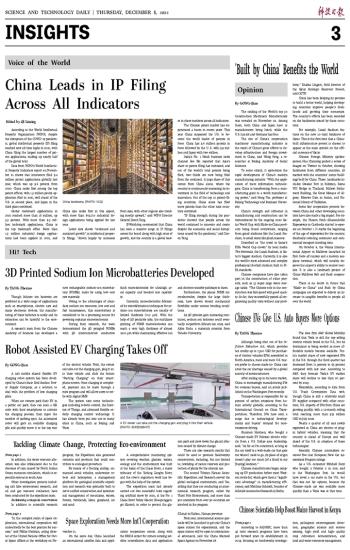
 'Built by China' Benefits the World
'Built by China' Benefits the World China Leads in IP Filing Across All Indicators
China Leads in IP Filing Across All Indicators 3D Printed Sodium Ion Microbatteries Developed
3D Printed Sodium Ion Microbatteries Developed Chinese EVs Give U.S. Auto Buyers More Options
Chinese EVs Give U.S. Auto Buyers More Options Robot Assisted EV Charging Takes Off
Robot Assisted EV Charging Takes Off Tackling Climate Change, Protecting Eco-environment
Tackling Climate Change, Protecting Eco-environment Chinese Scientists Help Boost Maize Harvest in Kenya
Chinese Scientists Help Boost Maize Harvest in Kenya Space Exploration Needs More Int'l Cooperation
Space Exploration Needs More Int'l Cooperation
Though lithium-ion batteries are preferred in a wide range of applications such as smartphones, electric cars and many electronic devices, the manufacturing of these batteries is costly and its extraction can be harmful to the environment.
A research team from the Chinese Academy of Sciences has developed a new rechargeable sodium-ion microbattery (NIMBs), made by using low-cost raw materials.
Owing to the advantages of abundant sodium ion resources, low cost and fast transmission, this microbattery is considered to be a promising source for powering coplanar microelectronics.
During their research, the team demonstrated the 3D pringted NIMBs with 3D interconnected conductive thick microelectrodes for ultrahigh areal capacity and boosted rate capability.
Currently, microelectrodes fabricated by microfabrication techniques for sodium-ion microbatteries are usually of limited thickness (<10 μm). With the help of 3D printable inks, the multilayer printing of NIMB microelectrodes can reach a very high thickness of almost 1200 μm while maintaining effective ion and electron-transfer pathways in them.
Furthermore, the planar NIMB microelectrodes, despite the large thickness, have shown decent mechanical flexibility under various bending conditions.
As 3D printers gain increasing resolution, sodium ion batteries could eventually outperform lithium-ion ones, said Akira Kudo, a materials scientist from Tohoku University.


 Next
Next



